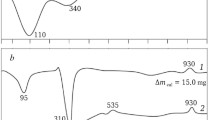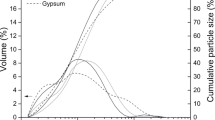Abstract
The changes occurring in the crystallised phases during degradation of an ordinary Portland cement have been studied. Leaching of cement paste with demineralised water generates a series of dissolution boundaries. Portlandite, then AFm, ettringite and calcite dissolve successively. In the zones with no change in mineralogy, local chemical equilibrium and decreasing gradients in calcium and hydroxyls between the core and the surface explain the precipitation of the secondary phases, like AFm, ettingite and calcite. Hydrogarnets in the surface layer in contact with the aggressive solution only dissolved slightly, or not at all. The very low solubility of hydrotalcites at pH values near neutrality explains the preciptation of these magnesium-containing phases in the surface layer.
Résumé
L’évolution des phases cristallisées durant la dégradation d’un ciment Portland ordinaire a été étudiée. La lixiviation d’une pâte de ciment par une eau déminéralisée provoque une série de dissolutions: la portlandite se dissout la première, puis les AFm, l’ettringite et la calcite. Dans des zones de minéralogie constante, l’équilibre chimique local et les gradients décroissants en calcium et hydroxyles entre le cœur et la surface explique les précipitations secondaires des phases présentes (AFm, ettringite, calcite). Les hydrogranats dans la couche de surface en contact avec une solution agressive se dissolvent peu ou pas de tout. La faible solubilité des hydrotalcites à des pH proches de la neutralité explique la précipitation des ces phases magnésiennes dans les couches de surface.
Similar content being viewed by others
References
Flint, E.P. and Wells, L.S., ‘Study of the system CaO−SiO2−H2O at 30°C and the reaction of water on the anhydrous calcium silicates’J Research. NBS. 12 (1934) 751–783.
Taylor, H.F.W., ‘Hydrated calcium silicates: Part I, Compound formation at ordinary temperatures’,J. Chem. Soc. London. 276 (1950) 3682–3690.
Greenberg, S.A. and Chang, T.N., ‘Investigation of the hydrated calcium silicates, II. Solubility relationships in the calcium oxidesilica-water system at 25°C’,J. Phys. Chem. 69 (1965) 1151–1157.
Taylor, H.W.F., ‘Cement Chemistry’ (Academic Press Limited, London Phase, 1990).
Jones, F.E., ‘Chemistry of Cements’, Proceedings of the Fourth International Symposium, Whshington, 1960) (National Bureau of Standards Monograph, 43 (US Department of Commerce, Washington, 1962) Vol 1, 205.
Novak, G.A. and Gibbs, G.V., ‘The crystal chemistry of the silicate garnets’,Amer. Mineral. 56 (1971) 791–825.
Sacerdoti, M. and Passaglia, E., “The crystal structure of katoite and implications within the hydrogrossular group of minerals’,Bull. Mineral. 108 (1985) 1–8.
Damidot, D. and Glasser, F.P., “Investigation of the CaO−Al2O3−SiO2−H2O system at 25°C by thermodynamic calculations’,Cem. Conc. Res. 25 (1995) 23–28.
Adenot F., ‘Durabilité du béton: Caractérisation et modélisation des processus physiques et chimiques de dégradation du ciment’, Thesis, Université d’Orléans, 1992.
Newkirk, T.F. and Thwaite, R.D., ‘Pseudoternary system calcium oxide-monocalcium aluminate (CaO Al2O3) dicalcium ferrite (2CaO.Fe2O3)’,J. Res. Natl. Bur. Stand. 61 (1958) 233–245.
Mascolo, M. and Marino, O., “A new synthesis and characterisation of Mg−Al hydroxides’,Min. Mag. 43 (1980) pp. 619–621.
Atkins, M., Glasser, F.P., Kindness, A. and Macphee, D.E., ‘DOE Report No DOE/HMIP/RR/91/*** (Department of the Environment, Aberdeen University, 1991).
Author information
Authors and Affiliations
Additional information
Editorial note Prof. Richard Cabrillac is a RILEM Senior Member, P. Faucon and F. Adenot work at the CEA (French Atomic Energy Commission), a RILEM Titular Member.
Rights and permissions
About this article
Cite this article
Faucon, P., Adenot, F., Jorda, M. et al. Behaviour of crystallised phases of Portland cement upon water attack. Mat. Struct. 30, 480–485 (1997). https://doi.org/10.1007/BF02524776
Received:
Accepted:
Issue Date:
DOI: https://doi.org/10.1007/BF02524776




